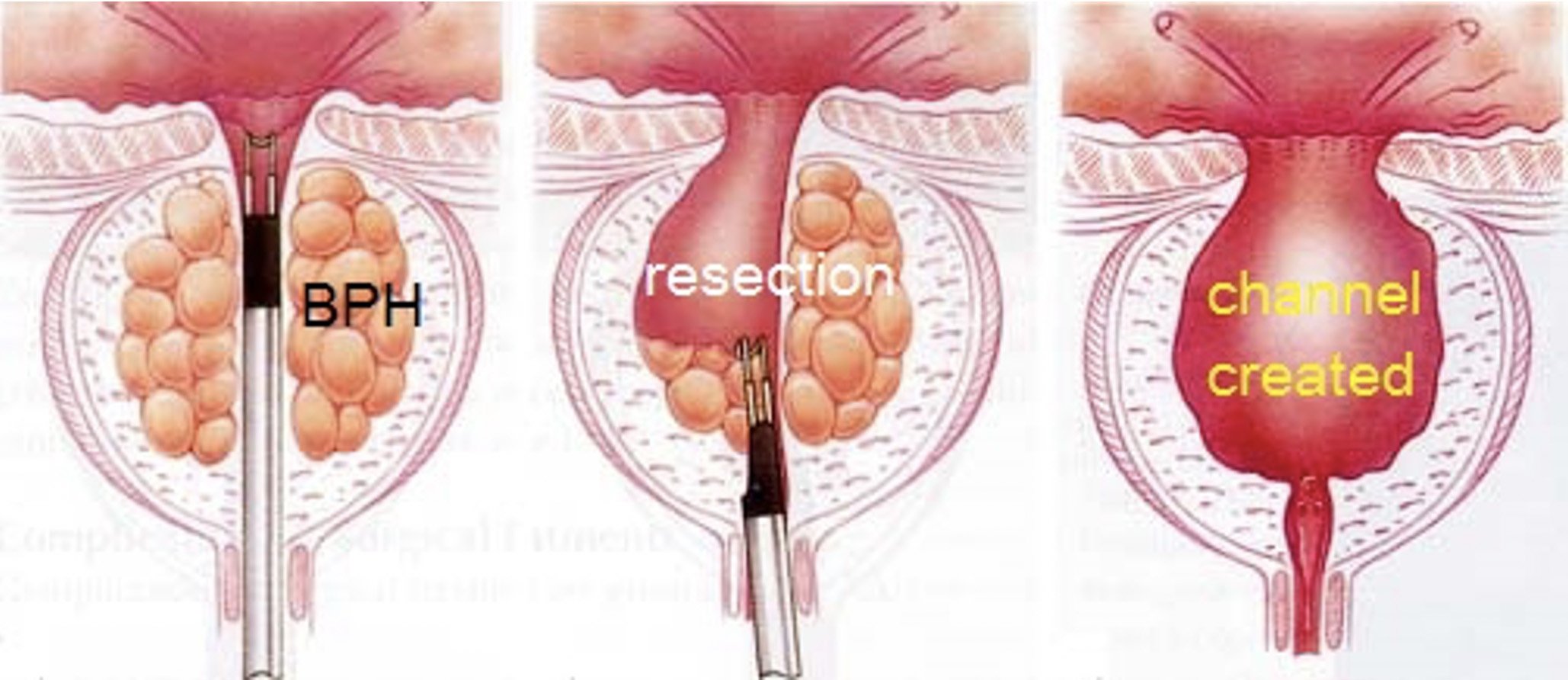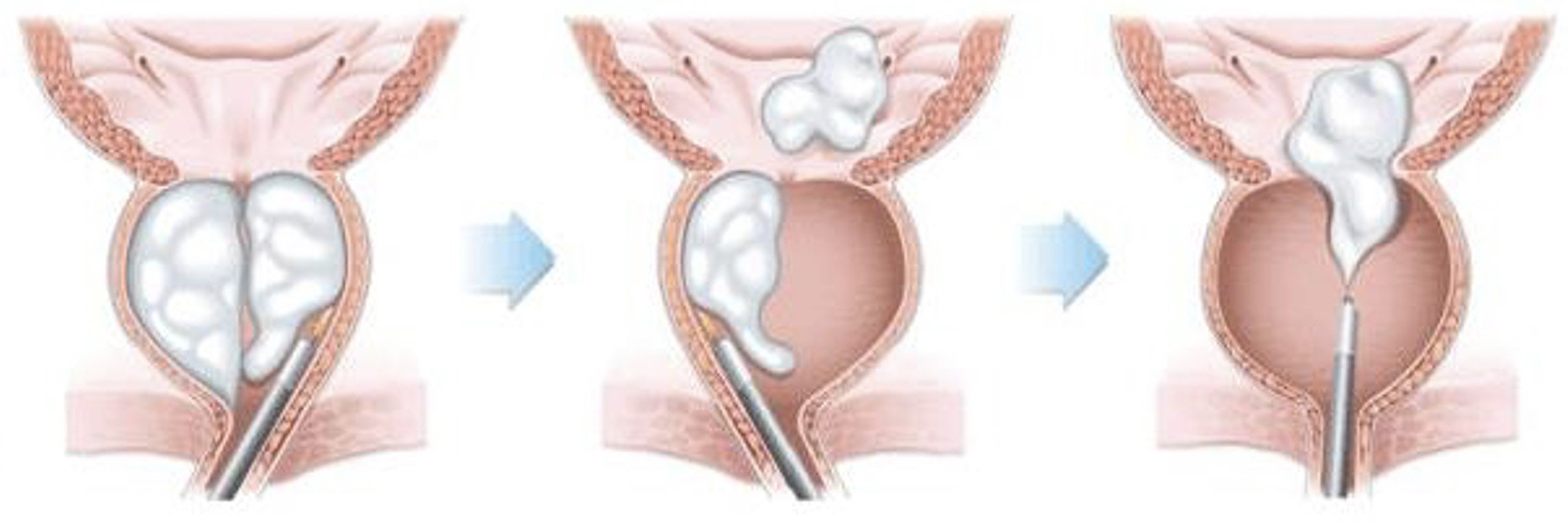Prostatectomy TURP/LASER
Figure 1: TURP for an enlarged prostate
What are the indications for a TURP Laser Prostatectomy?
Indications for this procedure include:
Lower urinary tract symptoms not improving with medication
Unable to pass urine (urinary retention)
Unable to empty bladder completely (chronic retention)
Bladder stones
Recurrent bleeding from enlarged prostate
Kidney problems from pressure on bladder from enlarged prostate
What pre-operative work up is needed?
Your urologist will organise any necessary urine and blood tests and imaging scans at your consultation prior to your procedure.
If you take any blood thinning medication, you should discuss with your urologist if these need to be stopped before your procedure. In general, aspirin can be continued in most cases but other medications such warfarin, plavix (clopidogrel) and anticoagulants may need to be stopped temporarily.
Please ensure you return any admission forms given to you to be filled out back to the hospital.
What happens on the day of the procedure?
You will be given fasting instructions prior to your admission (usually for 6 hours prior to the procedure). You should bring a list of your medications, and any recent scans or reports with you to the hospital. After you are admitted from the admission lounge, your urologist will see you to discuss the surgery. An anaesthetist will see you to discuss the anaesthetic (either general or spinal) before you are taken to the operation theatre. You may be provided with a pair of TED stockings to wear to prevent blood clots from developing and passing into your lungs.
What does this procedure involve?
Figure 2: HOLEP LASER prostatectomy for an enlarged prostate
The prostate gland sits around the urethra as it leaves the bladder and, when it enlarges, it may block the flow of urine.
The procedure involves passing a telescope through your urethra and coring or shaving out the central part of your prostate gland using electricity or laser; this creates a wide channel, which allows urine to flow more easily.
After a general or spinal anaesthetic and an injection of antibiotics, a telescope is passed into your bladder through the urethra. Electricity or a laser fibre (pictured) is used to peel away pieces of the obstructing prostate tissue (prostate lobes) from the surrounding capsule of the prostate. The peeled pieces are flushed into the bladder and sucked out and sent for pathology analysis. Any bleeding is stopped and a catheter is inserted into your bladder at the end of the procedure.
The bladder is irrigated through the catheter to flush through any clots or bleeding for a brief period after the surgery. The bladder catheter is removed within the first 1-2 days after your surgery. The procedure usually takes about two hours to complete and you can usually expect to be in hospital for 1-2 nights.
If you cannot pass urine when the catheter is removed, you then go home with this catheter and return a week or so later for a second catheter removal; this is successful in most patients.
Are there any risks or side-effects of a TURP or laser prostatectomy?
Mild burning on passing urine for a few days 50-100%
Blood in the urine for a few days after the procedure 30-40%
Delayed bleeding requiring further surgery to remove blood clots 2-5%
Infection of the bladder requiring antibiotic treatment 2-5%
Long term leakage of urine (Urinary incontinence) 2%
Short team leakage is common after HOLEP LASER surgery which should improve with pelvic floor exercises
Dry orgasm (retrograde ejaculation) 80-100%
Weaker erections 5-10%
Temporary worsening of urgency and frequency 20-30%
In long term this improves in 80% of patient
Unable to empty bladder despite procedure 2-5%
Bladder injury requiring catheter insertion / open repair 1-2%
Urethral stricture (scar tissue formation in waterpipe) 1-2%
Damage to the ureters (tubes draining urine from kidney) 1-2%
Major anaesthetic or cardiovascular problems - rare
What can I expect after discharge when I get home?
You may find it painful to pass urine at first and it may come more frequently than normal. You can relieve any initial discomfort with painkillers such as Paracetamol, and frequent passage of urine usually begins to improve within a week or so. The laser technique removes a lot of tissue so you may find your urinary control is not perfect at first. This improves as your pelvic floor muscles recover with exercises and, for most men, this settles over a short period.
You should drink twice as much fluid as you would normally for the first 24 - 48 hours, to flush the blood and debris out of your system and reduce the risk of infection.
Some loss of urinary control is common in the early days, so it is helpful to start pelvic floor exercises as soon as possible; these can improve your control when you get home.
The symptoms of an overactive bladder (frequent & urgent urination) can take up to three months to settle, whereas the flow of urine is usually improved immediately.
You may return to light work in 2 weeks when you are comfortable enough and when your GP is satisfied with your progress usually two weeks later. You should avoid strenuous activity, driving or straining on the toilet (laxatives and high fibre diet will help) for 4 weeks.
You may get some bleeding 2-3 weeks after getting home due to scabs separating from the cavity of the prostate. If this happens, you should increase your drinking; if it does not settle, you should contact your GP who will prescribe antibiotics for you. If you have severe bleeding, pass blood clots or have sudden difficulty passing urine, you should come to the emergency department.
What follow-up will I need?
Your urologist will generally see you in the clinic in the next 3-4 weeks.


